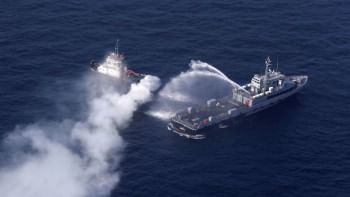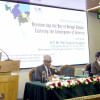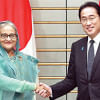The Bay of Bengal and Bangladesh in the Indo-Pacific region

Our Planet Earth is predominantly made up of oceans, with 71 percent of its surface covered in water. The Indian Ocean, the third largest ocean, is often referred to as the "Great Middle Bay" due to its location. The Bay of Bengal, the world's largest bay, measuring 2.17 million sq-km, can be seen as the central bay within the "Great Middle Bay" of the Indian Ocean.
As the Indo-Pacific narrative takes centre stage in global discussions, the Bay of Bengal is emerging as a critical region in the competition for control of sea lanes and global trade. Bangladesh's strategic location at the apex of the Bay of Bengal brings significant responsibilities as a facilitator and connector between regions and competing powers. Bangladesh's role in reviving regional connectivity holds global significance in the Indo-Pacific narrative, making it a key player in shaping the future of the region.
The Indian Ocean: Relevance for global trade, energy, and food security
Over 90 percent of global trade uses sea routes, with over 80 percent of maritime oil trade passing through the Indian Ocean. China's trade with ME, Africa, and Europe transits the Indian Ocean, while India's maritime trade is over 70 percent by volume. The Indian Ocean also holds valuable resources such as fisheries and minerals.
The Northern Indian Ocean is a crucial passageway for global east-west-east trade. Ensuring the uninterrupted flow of crude oil across the Indian Ocean and other oceanic regions is essential for major, middle, and minor powers. However, the risk of strategic competition escalating into active contestation is a danger that all must avoid.
Strategic importance of the Bay of Bengal in the Indian Ocean and power dynamics
The Bay of Bengal regains historically critical importance as an economic highway for commercial shipping routes between the Eastern and Western hemispheres. About half the world's container traffic passes through this region, while its ports handle approximately 33 percent of world trade.
The competition between India and China for access to Myanmar's offshore gas fields is driven by the quest for strategic resources such as oil and gas reserves and other minerals. The Northern Indian Ocean is a crucial trade route for global east-west-east trade. Ensuring the smooth flow of oil from the IOR to other oceanic regions is vital for major, middle, and minor powers. The risk of strategic competition escalating into active contestation is a looming danger that must be avoided.
The Bay of Bengal and the shaping of the Bangladeshi perspective
Bangladesh's historical legacy as part of pre-Partitioned Bengal shapes its perception of the region. Its strategic location at the apex of the Bay of Bengal positions it as a hub of connectivity between the Western and Eastern hemispheres, as well as the Indian Ocean and Pacific Oceanic regions.
With a significant youth population of nearly 50 percent of its over 170 million people, Bangladesh's demographic dividend is a potential force multiplier for even more accelerated growth in the future if effectively tapped into. It is a medium HDI country, ranking 129 out of 191 countries on UNDP's HDI list, outperforming other South Asian countries like India (131), Pakistan (161), and Afghanistan (180). Bangladesh's strategic value is further bolstered by its abundant hydrocarbon resources, including coal, oil, and gas, with significant potential.
The strategic importance of Bay of Bengal ports in colonial times
The discovery of hydrocarbon deposits in the Bay of Bengal region has shifted the focus of 21st-century neo-super colonial powers to this area, increasing its strategic significance. Enormous oil and gas reservoirs in the Bay of Bengal and its littorals, such as Sumatra, Indonesia, Malaysia, Thailand, Vietnam, and Brunei, prompted Dutch colonists to form Royal Dutch Shell. Bangladesh, too, is believed to have abundant reserves of hydrocarbons, but inadequately explored.
Technological innovations enabling offshore resource extraction, political instability in the Persian Gulf/Central-West Asia regions, turbulence in the West Asian socio-political environment, and the rise of China and India as global powers have influenced the geopolitical and commercial strategies of the US, EU, Japan, and China in the region.
Bangladesh as a champion of regional cooperation
Bangladesh has been a proactive champion of regional cooperation in South Asia, showing vision and bold initiatives. It led to forming Saarc in 1985 and proposed sub-regional cooperation resulting in SAGQ (South Asian Growth Quadrangle) and Bimstec (Bay of Bengal Initiative for Multisectoral, Technical and Economic Cooperation) in 1997. Bangladesh's visionary leadership led to the reincarnation of SAGQ as BBIN in 2015, making significant progress in reviving severed connectivity.
However, internal instability in Myanmar and the Rohingya crisis severely impedes these projects, stalling progress. Considering recent progress, expanding cooperation to embrace a Bay of Bengal Economic Cooperation (BoBEC) framework could be possible. Challenges like the Rohingya crisis and instability in Myanmar must be addressed for seamless regional connectivity and cooperation.
Towards greater cooperation in the Indo-Pacific regions
The Westphalian order led to European colonialism, while the fall of colonial powers after World War II marked the rise of new superpowers and the era of "neo-super colonialism." Lesser powers must strategise for survival in a world dominated by global giants. Similar to the "divide and rule" method of European colonial powers, neo-super colonists use similar tools to divide nations against each other in today's global power play.
The Bay of Bengal, an integral part of the Indian Ocean with a population of 1.7 billion and a GDP of $7 trillion, can form a "community" of nations bridging Saarc and Asean regions, enhancing overall cooperation. Sub-regional cooperation within Saarc and IORA could further contribute to regional cohesion.
The political economy of a probable Bay of Bengal "community"
The Bay of Bengal countries, with a population of 1.7 billion and a GDP of $7 trillion, can become a formidable "community." The region has a dispute-free maritime environment and fast-growing economies and is a battleground for competing narratives from significant superpowers. Collaboration among these countries is crucial to address ecological threats and ensure a sustainable blue economy.
A cohesive community of Bay of Bengal littorals, initially through a Bay of Bengal Economic Cooperation Association (BoBECA) that could evolve into a Bay of Bengal Community (BOBC), could unlock limitless possibilities for prosperity. Bangladesh has proactively fostered greater Bay of Bengal Economic Cooperation, promoting peaceful connectivity, trade, and social development. This leadership role would serve Bangladesh's self-interest, contribute to the collective regional interest, and enhance its sense of security. A regional governance framework for the Bay of Bengal microcosmic entity could serve as a model for other regions.
The Bay of Bengal countries have the potential to form a cohesive community that fosters economic cooperation, promotes peaceful connectivity, and addresses common challenges, charting a path towards prosperity and security for the region and beyond. And Bangladesh, as a bridging nation and a rising middle power, is well poised to play a leadership role, enjoying as it does equally good overall relations with all powers, whether competing or not.
After all, Bangladesh is situated at the epicentre of the Indo-Pacific!
This article is drawn from the 8th ISAS Public Lecture delivered by the author on January 26, 2023 in Singapore on the subject "Connectivity and Cooperation: Bangladesh in the Indo-Pacific Region."
Tariq Karim is a retired ambassador, and is currently the director of the Centre for Bay of Bengal Studies at Independent University, Bangladesh (IUB), a distinguished visiting research fellow at the Institute of South Asian Studies in the National University of Singapore (NUS), and honorary adviser emeritus of the Cosmos Foundation.

 For all latest news, follow The Daily Star's Google News channel.
For all latest news, follow The Daily Star's Google News channel. 











Comments